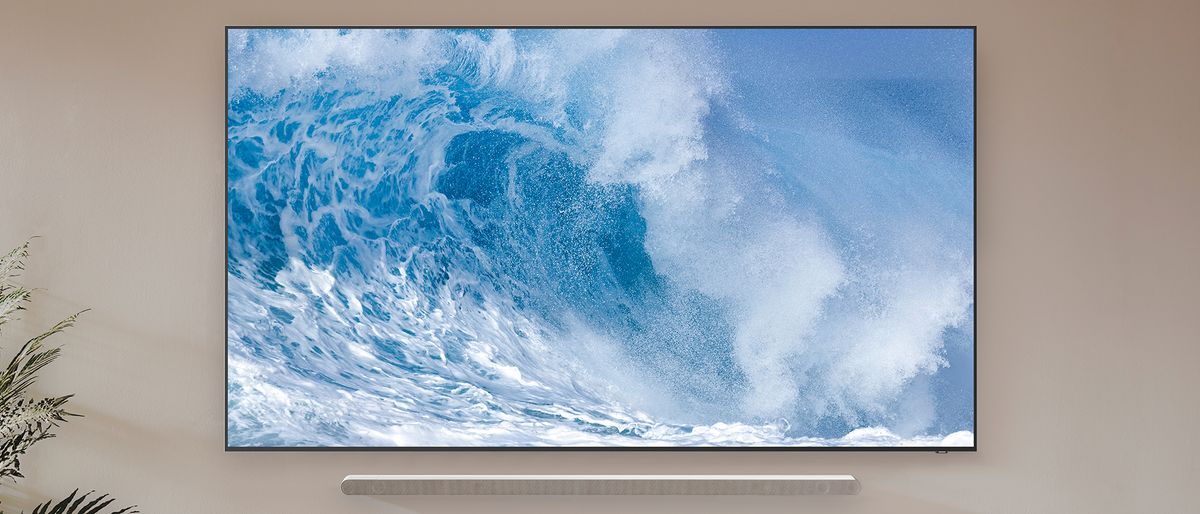TechRadar Verdict
Once again, Samsung's QN900B Neo QLED 8K TV has set the benchmark for Mini LED television technology, improving on its predecessor in a number of important ways, such as a noticeable reduction in light blooming, along with better image processing, brightness, audio and even design. While we have some reservations about Samsung's new (but not necessarily improved) user interface, you'd be hard-pressed to find a better LCD television this year.
Pros
- +
Increased backlighting accuracy
- +
Excellent colors
- +
Built-in Dolby Atmos
- +
Support for 144Hz gaming
Cons
- -
Lacks Dolby Vision support
- -
New 'Smart Hub' UI a step backwards
- -
Gimmicky NFT integration
Why you can trust TechRadar
One-minute review
From a purely technological standpoint, Samsung's new QN900B Neo QLED 8K TV improves upon last year's best-in-class QN900A Neo QLED 8K TV in every way, offering noticeable advancements in image processing (particularly when it comes to backlighting accuracy) and audio (built-in Dolby Atmos support works brilliantly with Samsung's Q-Symphony 2.0 technology).
So while the number of dimming zones offered by the QN900B's Mini LED-sporting panel hasn't changed since last year, its lighting accuracy has advanced drastically. This is thanks to an updated Neo Quantum Processor that boasts new Shape Adaptive Light technology. This employs AI algorithms to more accurately control the TV's backlighting output and match the shape of on-screen objects. The result is a huge reduction in light blooming from last year. This, combined with Samsung's Real Depth Enhancer tech, can produce truly standout images.
But it isn't all about image quality – sound has also received an overhaul this year, with the inclusion of built-in up-firing speakers that allow for immersive Dolby Atmos audio without the need for a soundbar. That said, the QN900B's updated Q-Symphony audio sounds even better when its speakers are combined with Samsung's soundbars, producing full, enveloping surround sound without any noticeable echo.
Samsung's 2022 TV lineup also sees the introduction of its brand new Smart Hub user interface, which debuted earlier in the year with The Freestyle projector. Unfortunately, we aren't too keen on this particular change.
We can see the reasoning behind Samsung's decision for the revamp, in that it gives users a full-screen, Google TV-style home menu that's packed with explorable content. However, those of us who simply want to adjust settings or viewing modes on the fly will find the experience frustrating and convoluted.
Samsung has put a considerable amount of thought into updating its Neo QLED flagship this year, addressing the (fairly minor) issue its previous model had regarding light blooming, and improving upon other areas that can always be better, like built-in audio. While we wouldn't necessarily recommend an upgrade for those who bought last year's model, the Samsung QN900B Neo QLED 8K TV is a great starting point for those new to Mini LED.
Price and availability
We're pleased to report that each set in Samsung's second generation of 8K Neo QLED televisions is priced slightly lower than its predecessor.
Samsung's QN900B Neo QLED 8K TV starts at $4,999 (£5,799 / AU$5,799) for a 65-inch model, followed by a 75-inch model at $6,499 (TBA / AU$7,999), and topping out with an 85-inch version priced at $8,499 (£10,999 / AU$11,999).
In terms of availability, the QN900B is available for pre-order now in the US, UK and Australia, and is expected to arrive in early May 2022.
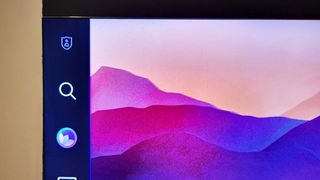
Design
- Industry-leading, bezel-free design
- Handy One Connect box
- Improved anti-glare coating
In terms of its industrial design, last year's Neo QLED 8K flagship came close to perfection, and now the QN900B comes even closer still.
Screen Sizes: 65, 75, 85-inches | Tuner: Freeview Plus | 8K: Yes | HDR10: Yes | HLG: Yes | Dolby Vision/Atmos: No/Yes | Panel technology: Mini LED (LCD) | Smart TV: Samsung / Tizen OS | Curved: No | 3D: No | Inputs: 4x HDMI 2.1 (1x eARC), 3xUSB, 1xRF, ethernet | Outputs: 1x optical
Once again, Samsung goes for stark minimalism, delivering a practically bezel-free 'Infinity' display that allows you to simply focus on the content you're watching without any harsh, noticeable lines boxing it in. We were in love with this approach in 2021 and we're still enamored by it today.
You may remember that 2021's QN900A sported speakers that weren't visible from the front of the television, opting instead to have them embedded along the side and top edges of the screen. Samsung has kept this aesthetic in 2022, albeit with a slight revision to its grille – last year's model had a dotted design, while this year's version sports larger, pill-shaped diagonal holes. This time, the grilles house a 90W 6.2.4 channel system (12 speakers), as opposed to the 80W 6.2.2 channel (10 speakers) setup we got last time around.
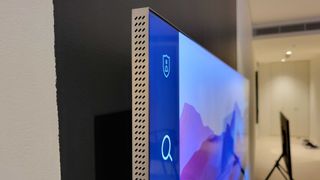
Although the unit we reviewed was wall-mounted, the QN900B comes with a near-identical stand to 2021's QN900A, and that's absolutely a good thing. It's flat, centered (meaning your TV screen can be wider than the surface you place it on), and allows you to mount Samsung's attachable One Connect box to the back of it if you so wish.
Oh yes, Samsung's game-changing One Connect box returns this year, giving users easy access to all of the QN900B's ports, with only a single near-transparent cable running back to the screen itself for power and data transfer. We simply cannot overstate how great this approach is.
On the One Connect box, you'll find four HDMI 2.1 ports (eARC support is found in HDMI 3), an ethernet (LAN) port, a Digital Audio Out (Optical) port, three USB 2.0 ports, and an RF input for your TV antenna or satellite connection.
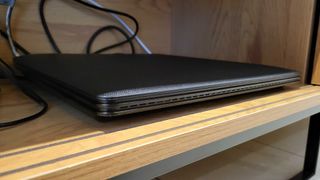
With last year's top Neo QLED model, we noted that there was room for improvement when it came to visible glare and reflections on the screen. To our eyes, it appears as though the QN900B has improved its screen's anti-reflection layer, but only very slightly, as we can still make out reflections from our environment during darker scenes.
So why is Samsung yet to release a Neo QLED TV with a matte finish / anti-glare display, similar to the impressive one featured on The Frame's 2022 revision? When asked, the South Korean company revealed to us that matte screens diffuse light on both the inner and outer layers of a display that "would reduce the sharpness and not allow 100% of the required light to pass through." In Samsung's own words, its "Neo QLED TVs are about being vibrant and sharp," so it comes as no surprise that it would want to avoid compromising that.
Smart TV (Tizen OS) and remote
- Excellent app support
- New Smart Hub UI is convoluted
- Get that NFT garbage outta here!
Samsung's 2022 TV range sees the introduction of its new Smart Hub UI across its top models. It's a totally revamped interface that's anchored by a Google TV-inspired home screen populated by content recommendations from your various streaming subscriptions and apps.
For its intended purpose, which is to highlight TV shows and movies from a variety of sources in a single place, it works well enough. That said, it takes up the whole display, which means the small, unobtrusive pop-up home menu that's been a staple of Samsung's Smart TV experience for the last few years is a thing of the past.
Unfortunately, the change to a full-screen, content-packed home menu brings about some frustration. No longer can you easily adjust settings and change viewing modes on the fly – you now have to completely leave what you're watching or playing when bringing up said home screen, navigate to a sidebar menu, and then scroll down to a separate settings menu to perform actions that were just a few button presses away before.
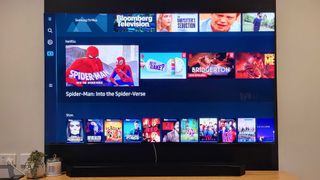
Thankfully, Samsung's smart TV platform still offers access to all the major streaming apps and services, with the likes of Netflix, YouTube, Disney Plus and Amazon Prime Video all present and accounted for.
In saying that, there is another aspect of the QN900B's smart TV experience that, at best, feels like a gimmicky inclusion and, at worst, could encourage people to spend hundreds, nay, thousands of dollars on digital items of questionable worth. We are, of course, talking about the QN900B's ability to access the non-fungible token (NFT) marketplace called Nifty.
The marketplace allows users to buy and sell crypto-art using the cryptocurrency Ethereum, which can then be displayed on your television via its popular Ambient Mode. If you're like this writer, and your blood curdles at the mere mention of NFT nonsense and its hype-driven infiltration of our society, you may find its presence on your home screen a little off-putting.
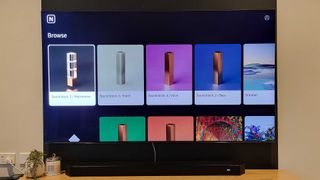
On a lighter note, Samsung's wonderful light-powered TV remote returns this year, once again saving us (and the environment) from the long-term devastation of disposable batteries.
Instead, the remote can be charged over time via a rear solar panel that absorbs light, both natural and artificial. Alternatively, you can quickly fill the remote's battery up via a USB Type C port on its bottom edge.
The remote itself is quite minimal, sporting only a handful of function and navigation buttons, along with volume and channel rockers. Dedicated Netflix and Prime Video buttons return, along with buttons to launch Disney Plus and Samsung's TV Plus app, which provides a wide number of digital channels packed with ad-supported news, sports and entertainment content. That means all the Ryan and Friends you can handle, free of charge.
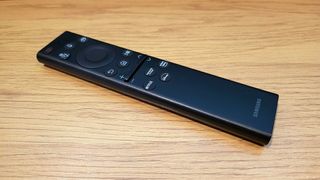
Performance
- Unmatched brightness and vibrancy
- Light blooming has been minimalized
- Outstanding support for gamers
As you'll no doubt remember, Samsung's Neo QLED moniker refers to the company's Mini LED TV product line, which delivers near-OLED contrast levels thanks to the inclusion of diodes that are 1/40th the thickness of regular LEDs. What that means is Samsung can cram thousands of smaller diodes into a panel rather than hundreds, resulting in a huge uptick in dimming zones and improved black levels.
In our review of last year's model, the QN900A, we noted that while its contrast levels were far greater than anything we'd seen before on an LCD TV, instances of light bleed were still evident.
Having since spent a great deal of time with last year's QN900A (it is this writer's primary television at home), we can state unequivocally that this year's revision sees a dramatic drop in light blooming around objects against darker sections of the display.
This can largely be attributed to the QN900B's updated Neo Quantum Processor 8K chip and its new Shape Adaptive Light technology, which uses artificial intelligence to ensure its backlighting matches the shape of on-screen objects more accurately.
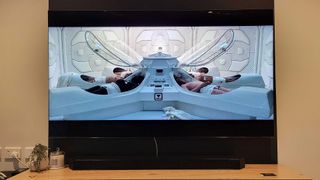
To see how well the new feature works, we returned to a scene from the film Alita: Battle Angel that was discussed in our QN900A review, which showed noticeable instances of light bleed on the television.
Our review noted how the scene in question showed the bright whites of Alita's chest plates bleeding into the black letterboxed area of the QN900A's display. Much to our delight, this instance of light bleed was completely absent from the scene when viewed on the QN900B. You can check out a comparison of how both sets handled the scene in the gallery below.



In terms of overall picture quality, we noticed improvements in both depth and contrast, with images in the foreground appearing punchier than before. Samsung's Real Depth Enhancer tech can be thanked for this, with its jump from 12-bit to 14-bit contrast mapping four times as many levels of monochromatic color gradation.
Following Alita, we booted up the visually striking CG-animated film Spider-Man: Into the Spider-Verse to test the QN900B's HDR prowess. It's a film that offers vibrant colors, inky blacks and scorching highlights, and the new Neo QLED flagship handled itself magnificently in each of these areas.
Colors appeared rich and accurate, with excellent contrast and highlights that were appropriately bright but also reined in when it came to light bloom. See the scene below as an example of the QN900B's brightness capabilities and its naturalistic approach to bloom.
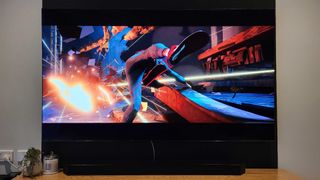
While the QN900B offers several motion-smoothing and noise reduction features, which tend to produce images that appear unnatural, these can thankfully be tailored to the viewer's preference in the TV's expert settings.
Alternatively, viewers can use the QN900B's Filmmaker Mode for the most authentic viewing experience of professionally produced video content. You should also know that this viewing mode doesn't shy away from film grain, which tends to be finer and more precise when viewed on an 8K panel.
As with any 8K TV, and given the limited amount of native 8K content on offer, upscaling will be of particular importance to users considering Samsung's QN900B Neo QLED TV. Thankfully, Samsung's Multi-Intelligence AI upscaling still does a great job of making older content look as clean as its source will allow.
Once again, we tested some older cartoons on Disney Plus and found them to look quite clean despite their 480p source. And because we hate ourselves, we also tested Ryan and Friends on the Samsung TV Plus app, which looked fairly crisp given its lower resolution.
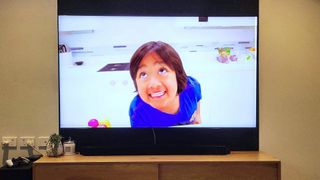
Just like last year's model, Samsung provides gamers with four HDMI 2.1 ports on the QN900B, giving them the ability to connect multiple consoles without sacrificing support for next-gen gaming features (4K/120fps or 8K/60fps, ALLM, VRR). As an added cherry on top, PC gamers also have the option of 144Hz support this year.
Once again, gamers will be happy to know that Samsung's latest Neo QLED flagship offers a comprehensive Game Mode, which allowers players to view frame rates, HDR status, resolutions and more. The mode also offers a handy Dynamic Black Equalizer that allows players to adjust the darkness of shadows, which could provide a competitive advantage.
Audio
- Surprisingly great built-in audio
- Impressive Q-Symphony mode
- Wireless Dolby Atmos for supported soundbars
Samsung's QN900B Neo QLED 8K TV boasts a variety of audio improvements over its predecessor, most notably the inclusion of up-firing speakers that make it possible to (technically) achieve Dolby Atmos sound.
Of course, there's only so much dimensionality that a television can produce without dedicated rear speakers and a standalone subwoofer. However, the QN900B does a pretty good job of bringing immersion to your listening experience thanks to Samsung's Object Tracking Sound Pro feature, which now lets you track noises moving vertically, as well as horizontally.
If you do have a compatible Samsung soundbar, however, you have the option of bringing it into perfect harmony with the QN900B's own speakers using the company's Q-Symphony tech, giving you a fuller audio experience, particularly when it comes to dialogue.
Additionally, Samsung's newest Neo QLED flagship now boasts the rather impressive ability to transmit Dolby Atmos audio to compatible Samsung soundbars over Wi-Fi, which could conceivably provide users with a spare HDMI port to take advantage of.
Should I buy the Samsung QN900A Neo QLED?
Buy it if…
You want the best that Mini LED has to offer
Mini LED lighting technology is already great, but Samsung has made it even better thanks to its clever implementation of AI and processing smarts.
You want an absolutely gorgeous television
Just like last year's model, the QN900B is the best-looking TV on the market, sporting a near-invisible bezel and speakers, and a stand that's both gorgeous and minimalist.
You want the ultimate television for gaming
Gamers will enjoy the QN900B's HDMI 2.1 and eARC features, which now offer 144Hz support for PC gaming enthusiasts.
Don't buy it if…
You already have last year's model
The QN900B is a fantastic TV, but its improvements are fairly incremental over its predecessor, meaning those who already own the previous model can hold out a bit longer.
You prefer simpler user interfaces
We won't mince words – Samsung's new Smart Hub UI is a step backward for the company, and we hope that a future firmware update will streamline it somehow.
[First reviewed April 2022]

Stephen primarily covers phones and entertainment for TechRadar's Australian team, and has written professionally across the categories of tech, film, television and gaming in both print and online for over a decade. He's obsessed with smartphones, televisions, consoles and gaming PCs, and has a deep-seated desire to consume all forms of media at the highest quality possible.
He's also likely to talk a person’s ear off at the mere mention of Android, cats, retro sneaker releases, travelling and physical media, such as vinyl and boutique Blu-ray releases. Right now, he's most excited about QD-OLED technology, The Batman and Hellblade 2: Senua's Saga.
Most Popular


